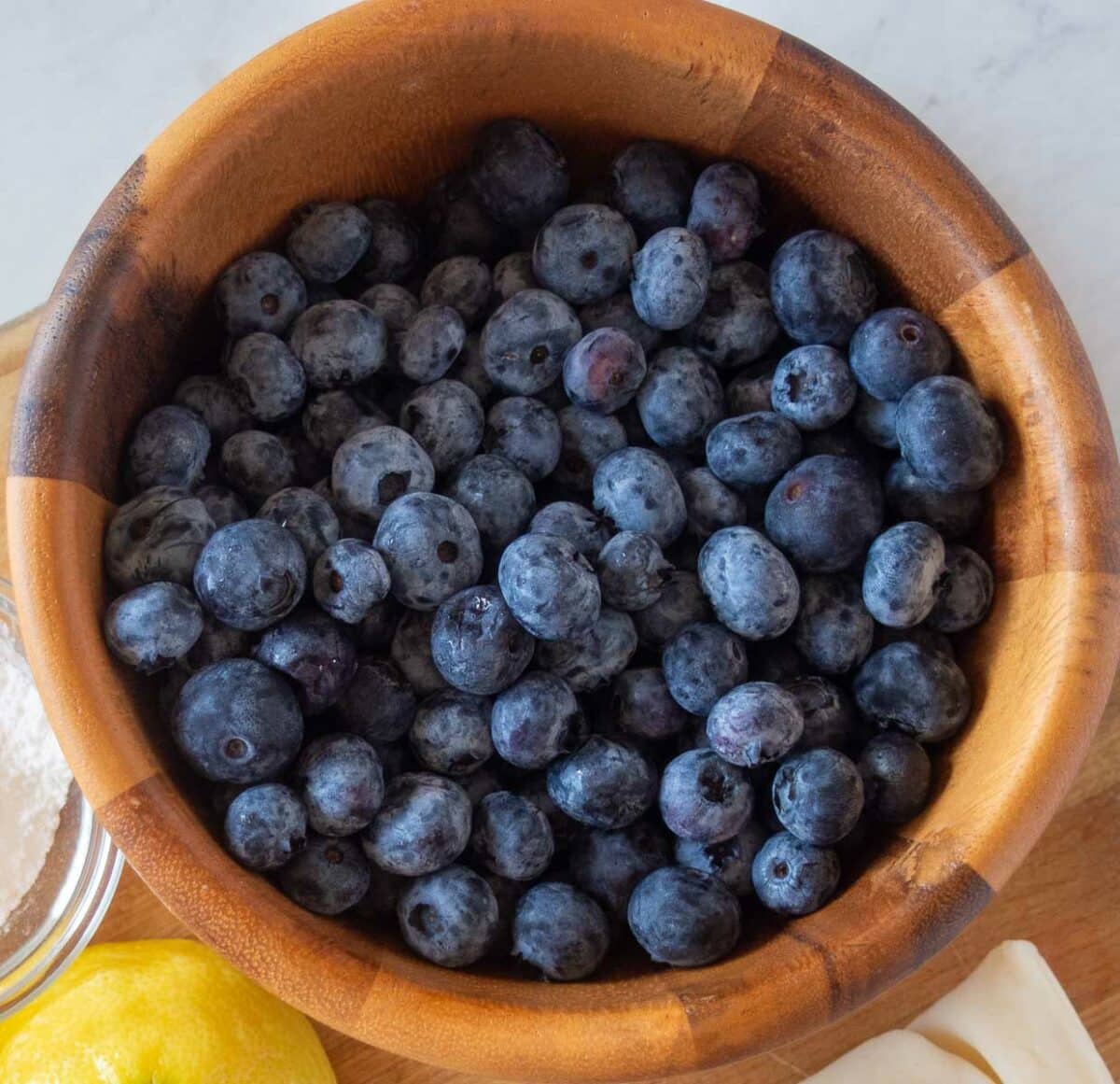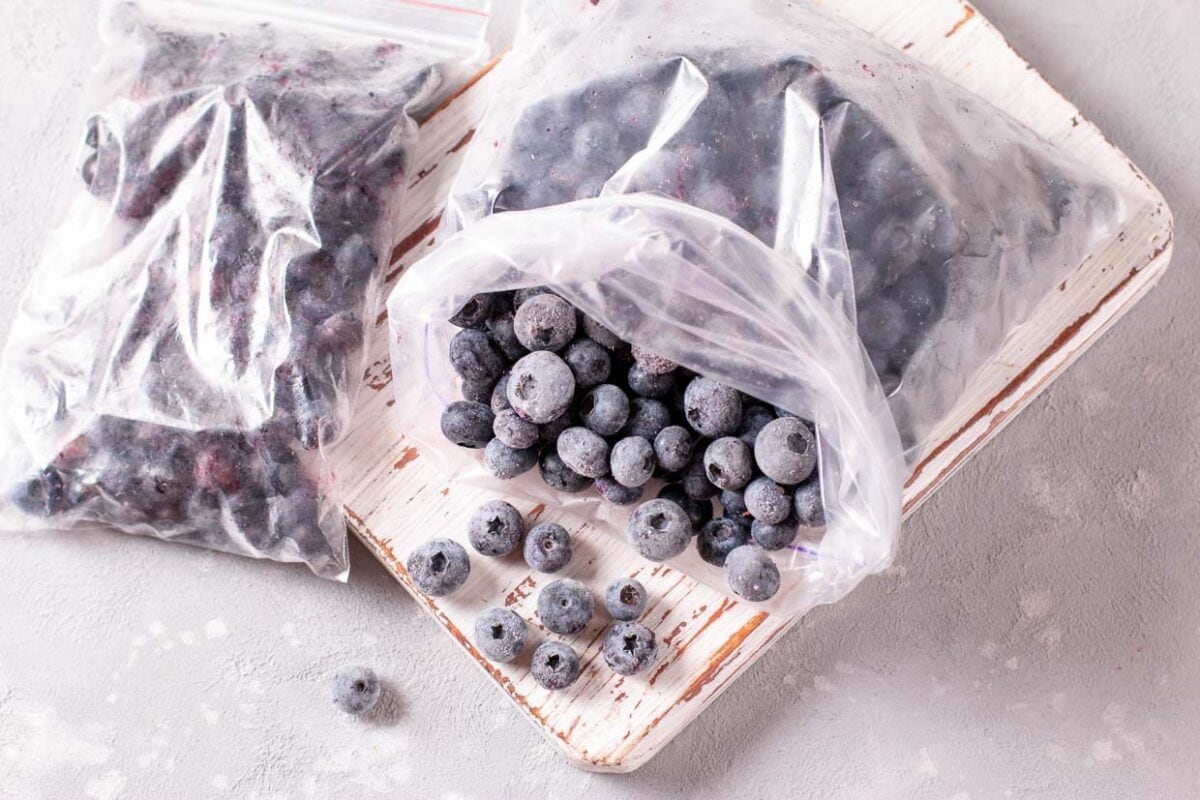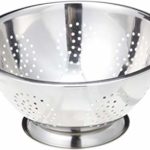That first taste of fresh blueberries in the middle of summer transports you to childhood, when you enjoyed those fresh and juicy blueberries by the handful. Learn how to freeze blueberries so you can enjoy this magic all year round and make delicious blueberry recipes, from a blueberry milkshake to blueberry muffins.
As an Amazon Associate I earn from qualifying purchases. Read my disclosure policy.
🫐What makes freezing blueberries tricky?
If you simply toss your fresh blueberries in the freezer, you are bound to have issues. Even when you purchase store-bought frozen blueberries, they are often mushy when you thaw them.
Blueberries, like most fruits and veggies, are made up primarily of water. In fact, according to Heathline, blueberries are 84% water.
As the water inside the berry freezes, it expands, which bursts the cell walls. So when you thaw them, you can end up with mushy berries. However, choosing the best ripe blueberries and using the right freezing technique helps retain more of the original flavor and texture that you want.
❔What are the best blueberries to freeze?

The best blueberries to freeze are small, wild blueberries. They maintain their texture better than the larger blueberries you typically see in the grocery store.
But, you can still successfully freeze the fresh blueberries you purchase at the store or farmers market. The key is to freeze them when you first buy them.
You want the freshest, ripe blueberries at the peak of summer blueberry season, when they are as firm as possible with no blemishes or signs of spoilage. The blueberry skin is thickest and most structurally sound at this point, which helps a lot. Overripe blueberries or moldy berries should never be used.
🥣How should you prep the blueberries?
Before you freeze the blueberries, give them a quick rinse in cool water. Warm or hot water will damage the skin and make them more likely to become mushy.
Be sure to pat them dry before you freeze them. Any moisture on the outside of the blueberry turns to ice and makes them lose the texture you want to maintain.
The easiest way to dry them is to put the berries on a double layer of paper towels, then gently use another paper towel to carefully roll them. Be gentle during this step, so you don’t damage the blueberries at all.
Alternatively, you can set them on a double layer of paper towels and let them rest for 10 to 20 minutes, then change out to new paper towels until they dry completely.
You do not need to use a fancy fruit and vegetable wash or spray. Water cleans them adequately. But you can also use three parts water mixed with one part vinegar, mix a tablespoon of 3 percent hydrogen peroxide with a gallon of water, or combine a teaspoon of salt with a cup of water to clean your produce.
“I have three blueberry bushes, so I freeze a lot of berries. Just wash them in baking soda mixed with vinegar to get the dirt off. This also inhibits bacteria. Rinse them well and lay them out on a kitchen towel to dry.”
— Jere’ Cassidy, One Hot Oven
🧊How to freeze blueberries

- Place your clean blueberries on a rimmed baking sheet lined with parchment paper. The parchment paper helps to ensure the blueberries don’t freeze to the metal pan and get damaged, while the sides of the pan makes sure the berries don’t roll off when you move the sheet pan to and from the freezer.
- Put the blueberries on the tray in a single layer, and do not pack them in. You are better off freezing a two trays, each with a single layer, than trying to get them all onto one sheet.
- Place your baking sheet in the freezer for two to three hours, until the blueberries are completely frozen.
- Once frozen, place them in a freezer-safe bag with as much air removed as possible, and then double bag them. Double bagging helps keep them from getting freezer burn and also protects their texture for longer. If you have a vacuum sealer, this is a great time to use it.
- Be sure to label your bag with the date you froze the fresh berries. They will keep in the freezer for up to six months.

👩🍳How can you use frozen blueberries?
Frozen blueberries are great to add to any recipe that calls for blueberries or just enjoy them by themselves.
For baking recipes, like a blueberry streusel coffeecake or sour cream blueberry muffins, be sure to add them to the batter while they are still frozen. They maintain their texture better when you don’t thaw them first.
For recipes like a blueberry crumble bar or blueberry sauce, it doesn’t matter if you thaw them before you add them to your recipe or not.
However, if you make a fruit salad or plan to use them to make blueberry pancakes or waffles — or anything with a short cook time — be sure to thaw them first.
“Freezing blueberries is so easy and it’s a great way to preserve the flavors of summer all season long. I love frozen blueberries with a square or two of chocolate for a late night snack.”
— Renee Gardner, Renee Nicole’s Kitchen
❤️Favorite blueberry recipes
Looking for delicious blueberry recipes? Try these below or check out all my favorite blueberry recipes!
❓How to thaw frozen berries?
The way you thaw blueberries is important to maintaining a good texture. They won’t become mushy berries if you thaw them correctly.
The best way to thaw them is to place them in the fridge for six to eight hours. Place the blueberries you want to thaw into an airtight container and cover it, then let them slowly thaw.
This minimizes the damage to the cell walls that makes them mushy. If you plan to thaw your entire batch, you can move the bag containing them to the fridge and thaw them in that.
If you need them more quickly, you can add them to a bowl of cold water, changing it with more cold water after five minutes or so. You may need to do this two to three times, depending on how many blueberries you want to thaw.
Do not thaw them in warm or hot water, as this will cause your blueberries to lose their texture. The same goes with thawing them in the microwave. Just don’t do it.
⭐Freeze them now, and enjoy them all year long
By following this simple process, you can ensure your frozen berries retain their firmness and taste as delicious as the day you first picked them. Whether you plan to add them to zucchini bread or enjoy them as a snack, you’ll love the burst of flavor properly frozen blueberries offer.
Did You Make This? Leave a Star Rating!

How to Freeze Blueberries
Ingredients
- Fresh blueberries
Instructions
- Quickly rinse blueberries in cool water.Fresh blueberries
- Pat them dry using paper towels or kitchen towels. Be sure to be gentle during this step, as you do not want to damage the blueberries at all.
- Place your clean blueberries on a rimmed baking sheet lined with parchment paper.
- Put the blueberries on the tray in a single layer and do not pack them in.
- Place your baking sheet in the freezer for two to three hours, until the blueberries are completely frozen.
- Once frozen, place them in a freezer-safe bag or airtight container with as much air removed as possible. Vacuum sealing or double bagging is also a great option.
- Be sure to label your bag with the date you froze them. Frozen berries will keep in the freezer for up to six months.
Notes
As an Amazon Associate and member of other affiliate programs, I earn from qualifying purchases.
Recommended Products
Nutrition facts are estimates.
Michelle Price is a food and travel writer at Honest and Truly who almost has an empty nest. She loves to provide both the inspiration and the confidence you need to help get you into the kitchen and on the road to enjoy new flavors and experiences.
This article first appeared on Food Drink Life.










